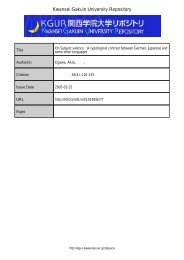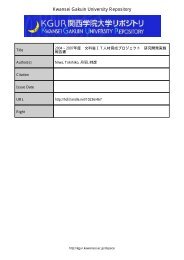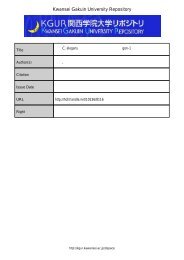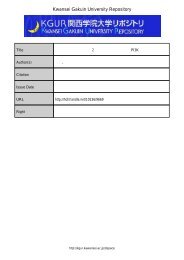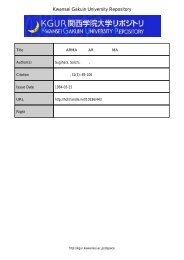Kwansei Gakuin University Repository
Kwansei Gakuin University Repository
Kwansei Gakuin University Repository
Create successful ePaper yourself
Turn your PDF publications into a flip-book with our unique Google optimized e-Paper software.
Industry growth is also included in the model. Higher industry growth is ex-<br />
pected to give a better environment in which new firms can survive and grow. On<br />
the other hand, high growth may lead to further investments and therefore fierce<br />
competition. In this respect, the risk of exit may be as high as the chance of suc-<br />
cess. The variable for industry growth (IG) is defined as the difference of shipments<br />
between the year of entry and the preceding year, divided by the value of shipments<br />
in the preceding year. Moreover, an industry’s entry rate may affect the probability<br />
of exit. It is well known that entry and exit are positively correlated with each<br />
other (e.g., Geroski, 1995). Geroski et al. (2010) found that, in practice, entry rates<br />
at founding persistently decrease the probability of survival. An industry’s gross<br />
entry rate (ENT RY ) is defined as the number of new establishments, divided by<br />
the number of existing establishments. 15<br />
In addition to industry-specific characteristics, we examine the effects of region-<br />
specific characteristics on exit. A number of studies have examined how regional fac-<br />
tors affect the survival and exit of new firms. In particular, there have been contra-<br />
dictory arguments about the impact of regional agglomeration (or concentration) on<br />
survival. Positive arguments suggest that high regional agglomeration leads to easy<br />
access to suppliers or customers and favors knowledge spillovers from other firms.<br />
On the other hand, negative arguments maintain that increases in regional agglom-<br />
eration tend to be associated with fierce competition within regions and therefore<br />
lead to higher probability of exit of firms. For example, Strotmann (2007) examined<br />
the determinants of survival of new German firms and found that agglomeration<br />
negatively affects the probability of survival. For Japan, Honjo (2000b) found that<br />
regional agglomeration increases the probability of failure of new software firms.<br />
By contrast, Fotopoulos and Louri (2000a) examined the difference in the probabil-<br />
ity of survival of Greek firms between urban and rural areas, and found that new<br />
firms tend to survive in urban areas. In this paper, we examine the effect on the<br />
15 For more details on the construction of this variable, see footnote 7.<br />
15



